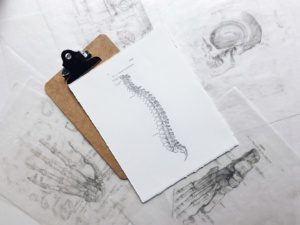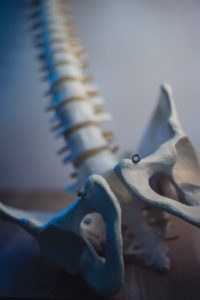Leg Pain in Endometriosis
Endometriosis is a multifaceted condition with a wide range of symptoms, making it challenging to diagnose. Menstrual irregularities and urinary problems are common signs, but the disease’s diverse nature extends to pain symptoms as well. Patients may experience abdominal, rectal, and back pain[1]. Intriguingly, musculoskeletal symptoms, which include muscle, bone, joint, and leg pain, have also been observed [2]. In this article, we delve into the topic of leg pain in endometriosis, shedding light on the underlying mechanisms and exploring the potential involvement of the sciatic nerve.
Endometriosis: Unraveling the Multifaceted Symptoms of the Condition

There are diseases with uniform symptoms. They include, for example, a sore throat. Endometriosis presents a wide range of manifestations. When tissue resembling the uterine lining grows outside the uterine cavity, it can lead to prominent symptoms. Approximately 65% of endometriosis patients experience menstrual cramps, infertility, back pain, nausea, bloating, and lower abdominal pain [3]. However, non-specific accompanying symptoms, such as leg pain radiating from the pelvis, are less discussed [4]. Unfortunately, since leg pain is not considered a leading symptom, it is often misattributed to other causes, leading to potential misdiagnoses. Orthopedists may associate it with muscular weakness, overlooking endometriosis as a possible cause. Even if they suspect the sciatic nerve, the underlying condition may remain undetected. This highlights the importance of a comprehensive and differentiated diagnosis.
Good to know!
Endometriosis can be a true symptom changer, leading women with unspecific pain on a lengthy medical journey. My advice is: trust your instincts, and, seek a second opinion when needed, to help ensure accurate classification and diagnosis of your symptoms.
When Endometriosis Affects the Pelvic Nerves
The pelvic nerves play a crucial role in the proper functioning of the body. They are responsible for ensuring that the pelvic organs can perform their essential functions. From having an orgasm to urinating or defecating, these processes are all made possible by the pelvic nerves. Moreover, they are vital for the proper function of the legs, allowing us to stand or walk with ease. Additionally, the pelvic nerves serve as the communication pathway, transmitting important information, including pain signals. Given the extensive responsibilities of the pelvic nerves, there can be several areas where issues may arise. Problems in this area can lead to voiding difficulties in the bladder and bowels, gait abnormalities, numbness, and radiating pain in the legs. In particular, leg pain can be an indicator of endometriosis affecting either the sciatic nerve or sacral roots [5].
Endometriosis and Sciatic Nerve Pain
The sciatic nerve (nervus ischiadicus) is an impressive component of the body, serving as the largest nerve in the organism and a vital information mediator. In connection with the spinal cord, it coordinates commands and sensations affecting the leg muscles and the brain. With several nerve roots converging, it sends movement commands from the brain to the leg muscles and sensory signals like touch and pain from the leg to the brain. Due to its extensive role as an “information radio operator,” it is susceptible to disorders, and one common condition is sciatica, caused by irritation of the sciatic nerve. Typically, this leads to a tearing painful sensation that can travel across the buttocks, posterior thighs, and even into the back of the knee [6]. Interestingly, these complaints are similar to those experienced when the sciatic nerve is affected by endometriosis.
 Symptoms of Sciatic Nerve Endometriosis
Symptoms of Sciatic Nerve Endometriosis
Infiltrating endometriosis that involves the sciatic nerve can pose significant challenges for physicians and patients. Endometriosis can spread within the sciatic nerve and cause damage [7].
Symptoms of endometriosis affecting the sciatic nerve include [8]:
- Regularly recurring pain along the sciatic nerve.
- Back pain.
- Pain in the buttocks, radiating into the back of the thigh and lower leg.
- Positive Straight Leg Raise Test (raising the leg straight up).
- Muscle weakness and altered reflexes.
- Sensory muscle loss.
Good to know!
While these symptoms may be indicative of endometriosis affecting the sciatic nerve, other causes could be responsible for the pain. For instance, endometriosis nodes or superficial endometriosis in the pelvic area might transmit the pain without directly irritating the sciatic nerve [9].
Endometriosis at the Sacral Roots
The sacral roots, located in the small pelvis, are nerve cords that emerge from the spinal cord and divide into many different nerves for the pelvic area. They are primarily located in the posterior pelvis. Endometriosis centered on the sacral roots is often less aggressive, with endometriosis tissue surrounding the nerves without causing harm. This type of endometriosis is frequently associated with deep infiltrating endometriosis that spreads from the vagina, bowel, or ureter. Usually, the lowest three sacral roots are affected among a total of five, responsible for maintaining bowel and bladder function and causing the clitoris to swell. Additionally, they supply crucial areas around the genitals and in the legs [5].
Symptoms of Endometriosis of the Sacral Roots
When endometriosis affects the sacral roots, it manifests in different parts of the body, leading to various symptoms [5]:
- Burning pain in the vulva area.
- Pronounced pain on the perineum and inner part of the buttocks.
- Pain spreading to the legs, perceived in the inner and rear parts.
- Symptoms resembling cystitis or irritable bowel syndrome.
Good to know!
Since these symptoms are also rather non-specific, it is essential for patients with deep infiltrating endometriosis in the vagina, bowel, or ureter to discuss any nerve pain with their doctors [5]. Leg pain is a vital clue that may be related to other endometriosis symptoms. Seeking advice from a specialist, such as an endometriosis center or neuropelveologist (specializing in pelvic nerves), can lead to correct diagnosis and appropriate management.
Diagnosing Leg Pain in Endometriosis
 The foundation of every diagnosis is anamnesis, which involves a thorough doctor-patient interview. The first step is to gather information about the existing symptoms, when they started, and the patient’s medical history. Knowing whether there is a previous diagnosis of endometriosis and details about past treatments can be crucial. A neuropelveological examination is also recommended. This specialized field focuses on pelvic nerve changes and associated complaints. During the examination, painful indurations are palpated, among other assessments. As in any gynecological examination for endometriosis, rectovaginal palpation is essential. This allows for the detection and palpation of nodes on the pelvic sidewalls in the region of the nerves. Ultrasound examination (vaginal or rectal) can provide additional clues. However, a definitive diagnosis of endometriosis requires a laparoscopy. For cases with concurrent leg pain, imaging of the sciatic nerve and a close examination are advisable [5]. Magnetic resonance imaging (MRI) examinations can be helpful in this context [10]. Additionally, nerve conduction has been used in studies to determine whether any nerve damage exists [11].
The foundation of every diagnosis is anamnesis, which involves a thorough doctor-patient interview. The first step is to gather information about the existing symptoms, when they started, and the patient’s medical history. Knowing whether there is a previous diagnosis of endometriosis and details about past treatments can be crucial. A neuropelveological examination is also recommended. This specialized field focuses on pelvic nerve changes and associated complaints. During the examination, painful indurations are palpated, among other assessments. As in any gynecological examination for endometriosis, rectovaginal palpation is essential. This allows for the detection and palpation of nodes on the pelvic sidewalls in the region of the nerves. Ultrasound examination (vaginal or rectal) can provide additional clues. However, a definitive diagnosis of endometriosis requires a laparoscopy. For cases with concurrent leg pain, imaging of the sciatic nerve and a close examination are advisable [5]. Magnetic resonance imaging (MRI) examinations can be helpful in this context [10]. Additionally, nerve conduction has been used in studies to determine whether any nerve damage exists [11].
An example from Practice
To illustrate the significance of accurate diagnosis, consider the case of a 25-year-old woman who experienced thigh pain for two months and sought medical attention. There was no history of injury in this area. Initially, a soft tissue injury was diagnosed and treated with anti-inflammatory medications and physical therapy. However, the pain worsened, spreading from the left buttock down the leg to the heel, with heightened intensity during menstruation. After two years, she developed a limp and was referred to an orthopedist. Sciatic endometriosis was not ruled out, and a surgical procedure confirmed the disease. Following the intervention, the patient experienced pain relief, regained mobility without crutches, and was able to extend her leg more comfortably [12].
How is Leg Pain Treated in Endometriosis?
When endometriosis affects the sciatic nerve, relying solely on hormonal preparations or painkillers is not sufficient. Due to the nature of deeply infiltrating endometriosis that can spread and cause lasting nerve damage, a laparoscopy is often necessary to remove the endometriosis lesions. This surgical approach also applies to cases where the nerve is infiltrated and damaged. In such situations, the surgeon must possess exceptional knowledge of the pelvic nerve and vessel anatomy. If endometriosis is observed in the area of the sacral roots, surgical intervention is also an option. However, in this case, the nerves are freed from the unwanted tissue while preserving them as much as possible. It is crucial for patients to know that nerve removal is not automatic, and detailed information about the risks and possibilities of the operation will be provided before the procedure. [13,14].
Good to know.
If you have been diagnosed with endometriosis in connection with leg pain, it is important to discuss with your healthcare provider whether medication therapy is still necessary despite the surgical intervention. The German Society for Gynecology and Obstetrics recommends considering progestin preparation as a first-line treatment. Progestin is a hormone that aims to counteract the excess estrogen often associated with endometriosis.
In a Nutshell
Endometriosis can manifest in a wide range of symptoms, and leg pain is one of the non-specific complaints that could be indicative of the condition. Leg pain may occur when the sciatic nerve or sacral roots are affected by endometriosis. However, pain transmission can also happen without direct nerve involvement. Described as pulling or tearing, leg pain in endometriosis can radiate from the buttocks to the back of the thigh, calves, and foot. If you have already been diagnosed with deep infiltrating endometriosis affecting the vagina, ureters, or bowel, it is crucial to discuss any nerve pain with your healthcare provider. The doctor-patient discussion plays a paramount role in making an accurate assessment. In addition, imaging procedures such as ultrasound or MRI can aid the diagnosis. However, a definitive assessment of the disease requires an abdominal endoscopy. Regardless of whether endometriosis affects the sciatic nerve or sacral roots, surgery is often the preferred course of action rather than medication. The surgical procedure involves removing the endometriosis tissue while preserving the nerves as much as possible. It is important to note that endometriosis on the sciatic nerve tends to be more aggressive than on the sacral roots. Your doctor will provide detailed information about how the procedure can improve your quality of line in the future.
Curious about other symptoms and complaints typical of endometriosis? Download the Endo-App and benefit from our expert knowledge.
References
- Riazi H, Tehranian N, Ziaei S, Mohammadi E, Hajizadeh E, Montazeri A. Clinical diagnosis of pelvic endometriosis: a scoping review. BMC Womens Health. 2015 May 8;15:39. doi: 10.1186/s12905-015-0196-z. PMID: 25952159; PMCID: PMC4450847.
- Lemaire GS. More than just menstrual cramps: symptoms and uncertainty among women with endometriosis. J Obstet Gynecol Neonatal Nurs. 2004 Jan-Feb;33(1):71-9. doi: 10.1177/0884217503261085. PMID: 14971555.
- Dietrich, Klaus: Gynecology and Obstetrics (Springer Textbook) 2. Auflage, Springer Verlag
- Endometriosis and pain (schmerzgesellschaft.de)
- Prof. Dr. med. Marc Possover: The endometriosis of the sciatic nerve and sacral roots.
- Ischias | Gesundheitsinformation.de
- Possover M, Chiantera V. Isolated infiltrative endometriosis of the sciatic nerve: a report of three patients. Fertil Steril. 2007 Feb;87(2):417.e17-9. doi: 10.1016/j.fertnstert.2006.05.084. PMID: 17276152.
- Foti PV, Farina R, Palmucci S, Vizzini IAA, Libertini N, Coronella M, Spadola S, Caltabiano R, Iraci M, Basile A, Milone P, Cianci A, Ettorre GC. Endometriosis: clinical features, MR imaging findings and pathologic correlation. Insights Imaging. 2018 Apr;9(2):149-172. doi: 10.1007/s13244-017-0591-0. Epub 2018 Feb 15. PMID: 29450853; PMCID: PMC5893487.
- Vilos GA, Vilos AW, Haebe JJ. Laparoscopic findings, management, histopathology, and outcome of 25 women with cyclic leg pain. J Am Assoc Gynecol Laparosc. 2002 May;9(2):145-51. doi: 10.1016/s1074-3804(05)60122-3. PMID: 11960038.
- Lomoro P, Simonetti I, Nanni A, Cassone R, Di Pietto F, Vinci G, Prevedoni MS, Romano S, Sammarchi L. Extrapelvic Sciatic Nerve Endometriosis, the Role of Magnetic Resonance Imaging: Case Report and Systematic Review. J Comput Assist Tomogr. 2019 Nov/Dec;43(6):976-980. doi: 10.1097/RCT.0000000000000916. PMID: 31688247.
- Volpi E, Ferrero A, Sismondi P. Laparoscopic identification of pelvic nerves in patients with deep infiltrating endometriosis. Surg Endosc. 2004 Jul;18(7):1109-12. doi: 10.1007/s00464-003-9115-8. Epub 2004 May 27. PMID: 15156387.
- Mannan K, Altaf F, Maniar S, Tirabosco R, Sinisi M, Carlstedt T. Cyclical sciatica: endometriosis of the sciatic nerve. J Bone Joint Surg Br. 2008 Jan;90(1):98-101. doi: 10.1302/0301-620X.90B1.19832. PMID: 18160509.
- Possover M, Schneider T, Henle KP. Laparoscopic therapy for endometriosis and vascular entrapment of sacral plexus. Fertil Steril. 2011 Feb;95(2):756-8. doi: 10.1016/j.fertnstert.2010.08.048. Epub 2010 Sep 25. PMID: 20869701.
- Possover M, Baekelandt J, Flaskamp C, Li D, Chiantera V. Laparoscopic neurolysis of the sacral plexus and the sciatic nerve for extensive endometriosis of the pelvic wall. Minim Invasive Neurosurg. 2007 Feb;50(1):33-6. doi: 10.1055/s-2007-970075. PMID: 17546541.
Erfahre mehr über Beinschmerzen bei Endometriose in unserem Symptom Explorer.
- “Take yourself and your endometriosis seriously. You are not imagining things!” - 5. November 2023
- Increased Risk of Stroke Due to Endometriosis - 4. October 2023
- Does Monk’s Pepper Help with Endometriosis? - 24. September 2023

The labyrinth of endometriosis, the article casts light upon the lesser-illuminated corridors of leg pain, a symptom so enigmatic it becomes a mystery within a mystery. The tale of the sciatic nerve’s involvement reminds us of the interconnectedness of our very being, where a disturbance in one realm can send echoes through another. It’s a poignant exploration of the silent cries of the body, urging us to heed not only the loud, but also the whispers. The narrative serves as an evocative testament to the complexity of diagnosis, where every symptom, no matter how faint its voice, holds a story waiting to be told.